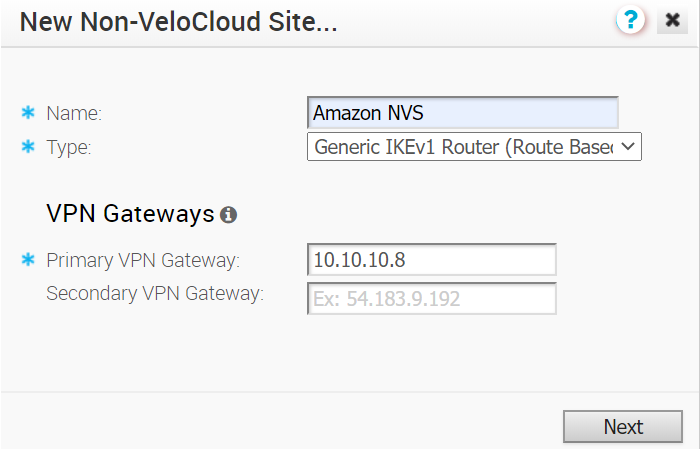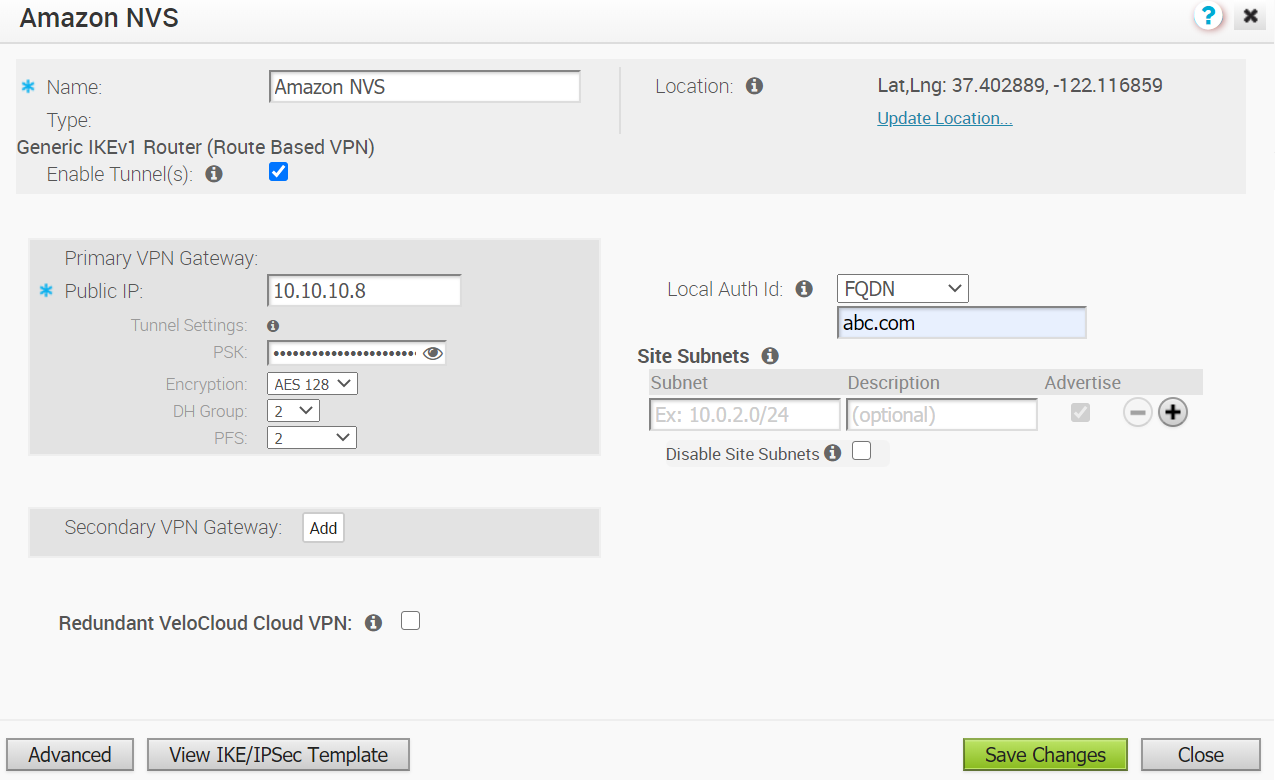After you obtain Public IP, Inside IP, and PSK information from the Amazon Web Services (AWS) website, you can configure a Non VMware SD-WAN Site.
To configure a Non VMware SD-WAN Site:
- Go to Configure > Network Services.
- In the Non-VeloCloud Sites area, click the New button.
- In the New Non-VeloCloud Site dialog box:
- Enter the name of your site.
- Select Generic IKEv1 Router (Route Based VPN) or Generic IKEv2 Router (Route Based VPN) from the Type drop-down menu.
- Type in the Primary VPN Gateway (and the Secondary VPN Gateway if necessary).
- Click Next.

A route-based Non VMware SD-WAN Site is created and a dialog box for your Non VMware SD-WAN Site appears.

- To configure tunnel settings for the Non VMware SD-WAN Site’s Primary VPN Gateway, click the Advanced button.
- In the Primary VPN Gateway area, you can configure the following tunnel settings:
Field Description PSK The Pre-Shared Key (PSK), which is the security key for authentication across the tunnel. The Orchestrator generates a PSK by default. If you want to use your own PSK or password then you can enter it in the textbox. Encryption Select either AES 128 or AES 256 as the algorithm to encrypt data. The default value is AES 128. DH Group Select the Diffie-Hellman (DH) Group algorithm to be used when exchanging a pre-shared key. The DH Group sets the strength of the algorithm in bits. The default value is 2. PFS Select the Perfect Forward Secrecy (PFS) level for additional security. The default value is 2. - If you want to create a Secondary VPN Gateway for this site, then click the Add button next to Secondary VPN Gateway. In the pop-up window, enter the IP address of the Secondary VPN Gateway and click Save Changes.
The Secondary VPN Gateway will be created immediately for this site and will provision a VMware VPN tunnel to this Gateway.
- Select the Redundant VeloCloud Cloud VPN checkbox to add redundant tunnels for each VPN Gateway.
Any changes made to Encryption, DH Group, or PFS of Primary VPN Gateway will also be applied to the redundant VPN tunnels, if configured. After modifying the tunnel settings of the Primary VPN Gateway, save the changes and then click View IKE/IPSec Template to view the updated tunnel configuration.
- Click the Update location link to set the location for the configured Non VMware SD-WAN Site. The latitude and longitude details are used to determine the best Edge or Gateway to connect to in the network.
- Local authentication ID defines the format and identification of the local gateway. From the Local Auth Id drop-down menu, choose from the following types and enter a value that you determine:
- FQDN - The Fully Qualified Domain Name or hostname. For example, google.com.
- User FQDN - The User Fully Qualified Domain Name in the form of email address. For example, [email protected].
- IPv4 - The IP address used to communicate with the local gateway.
Note:For Generic route based VPN, if the user do not specify a value, Default is used as the local authentication ID. The default local authentication ID value will be the SD-WAN Gateway Interface Public IP.
- Under Site Subnets, you can add subnets for the Non VMware SD-WAN Site by clicking the + button. If you do not need subnets for the site, select the Disable Site Subnets checkbox.
- Check the Enable Tunnel(s) checkbox once you are ready to initiate the tunnel from the SD-WAN Gateway to the Generic Router VPN gateways.
- Click Save Changes.